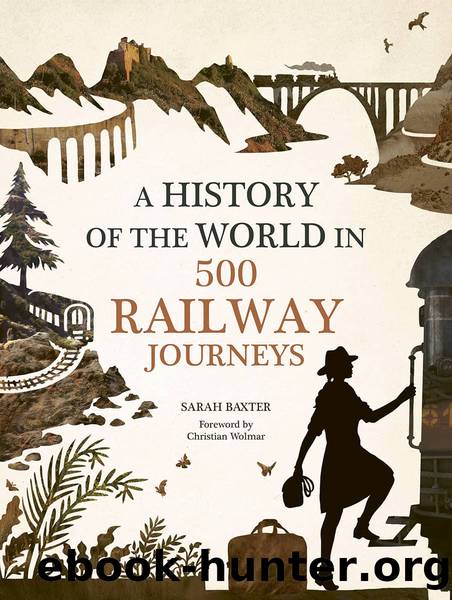History of the World in 500 Railway Journeys by Sarah Baxter

Author:Sarah Baxter
Language: eng
Format: epub
Publisher: White Lion Publishing
Published: 2019-11-15T00:00:00+00:00
Tren Cruceroâs eastbound voyage is called the Train to the Clouds, and starts in Durán, at the mouth of the Guayas River. This is the railhead for Guayaquil, Ecuadorâs second city, founded by Spanish conquistador Francisco de Orellana in 1538. In the early 16th century Ecuador was ruled by the Inca, but the Spanish conquered the country in 1534, and went on to rule Ecuador for 300 years. Only a smattering of colonial-era buildings remain in Guayaquil (an earthquake in 1942 flattened many). But thereâs old-school charm in the Barrio las Peñas neighbourhood, plus a lively waterfront promenade.
Guayaquil isnât just the Tren Cruceroâs beginning, itâs also where the story of Ecuadorean railways begins. The countryâs first line, opened in 1873, linked Durán to the inland city of Milagro. This is the route the Tren Crucero follows on Day 1, rumbling through sugar cane, banana and pineapple plantations via Milagro to the town of Bucay. The railway first reached Bucay in 1888 but, with the Andes looming on the horizon, construction stalled. It wasnât until 1901 that American engineer John Harman discovered a workable route forwards â via a mountainside overflown by condors, and a stretch known as the âDevilâs Noseâ.
On Day 2, the Tren Crucero sets off along the Chanchán River to follow Harmanâs audacious solution. The terrain morphs from lush cloud forest to more barren highlands as the train climbs. Then, at Sibambe Station, the train hits the vertiginous hairpins of the Devilâs Nose. Between here and the village of AlausÃ, the train ascends 500m (1,640ft) in just 7.5 miles (12km). After that it continues through the mountains, passing quinoa fields and grazing llamas en route to the city of Riobamba.
On Day 3 the Tren Crucero hits its highest point, 3,609m (11,840ft) Urbina Station, with bulbous Mount Chimborazo, Ecuadorâs highest peak, looming to the west. This heralds the Avenue of Volcanoes, along which twenty snow-capped, sometimes smoking volcanoes stand. Theyâre like a ceremonial welcome, trumpeting the trainâs arrival in Quito â just as they did on 25 June 1908, when the GuayaquilâQuito train completed its first run.
Founded by the Spanish in 1534 atop the ruins of an Inca city, Quito has the best-preserved historic centre of Spanish America. At its heart is the Plaza de la Independencia, a wide square edged by the whitewashed cathedral and the Government Palace. There are also many churches with rich âBaroque School of Quitoâ interiors.
On Day 4 the Tren Crucero travels between Otavalo and Ibarra, a journey described in Chapter 3. So thatâs almost every inch of Ecuadorean rail covered. Not bad given that at the start of the 21st century the network had almost ceased to exist.
Download
This site does not store any files on its server. We only index and link to content provided by other sites. Please contact the content providers to delete copyright contents if any and email us, we'll remove relevant links or contents immediately.
| Automotive | Engineering |
| Transportation |
Whiskies Galore by Ian Buxton(41525)
Introduction to Aircraft Design (Cambridge Aerospace Series) by John P. Fielding(32885)
Small Unmanned Fixed-wing Aircraft Design by Andrew J. Keane Andras Sobester James P. Scanlan & András Sóbester & James P. Scanlan(32570)
Craft Beer for the Homebrewer by Michael Agnew(17930)
Turbulence by E. J. Noyes(7695)
The Complete Stick Figure Physics Tutorials by Allen Sarah(7135)
Kaplan MCAT General Chemistry Review by Kaplan(6591)
The Thirst by Nesbo Jo(6432)
Bad Blood by John Carreyrou(6271)
Modelling of Convective Heat and Mass Transfer in Rotating Flows by Igor V. Shevchuk(6219)
Learning SQL by Alan Beaulieu(6031)
Weapons of Math Destruction by Cathy O'Neil(5825)
Man-made Catastrophes and Risk Information Concealment by Dmitry Chernov & Didier Sornette(5644)
Digital Minimalism by Cal Newport;(5388)
Life 3.0: Being Human in the Age of Artificial Intelligence by Tegmark Max(5182)
iGen by Jean M. Twenge(5158)
Secrets of Antigravity Propulsion: Tesla, UFOs, and Classified Aerospace Technology by Ph.D. Paul A. Laviolette(4984)
Design of Trajectory Optimization Approach for Space Maneuver Vehicle Skip Entry Problems by Runqi Chai & Al Savvaris & Antonios Tsourdos & Senchun Chai(4837)
Electronic Devices & Circuits by Jacob Millman & Christos C. Halkias(4743)
